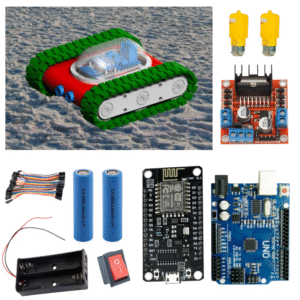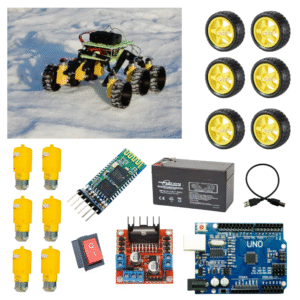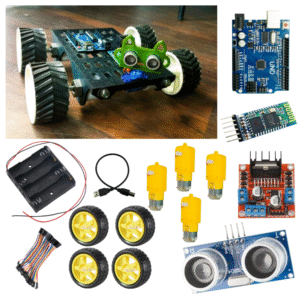From Tanks to Bionic Hands: 5 Robotics Kits That Take STEM Projects to the Next Level
1. Why Robotics Kits Inspire Innovation
Robotics combines hardware, software, design, and creativity. For students, hobbyists, and makers, building robots provides hands-on experience that no textbook can match. You see mechanics at work, you debug electronics, you solve problems, you learn programming—and you create something that moves, senses, or behaves.
SmartXProKits offers a range of robotics kits that push the envelope: moving tanks, stair-climbing rovers, bionic prosthetics, smart cars that avoid obstacles or follow your Bluetooth commands. Let’s explore five of these exciting kits and see what they offer.
2. Overview of the 5 SmartXProKits Robotics Projects
Here are the five kits we’ll discuss:
3D-Printed Tank Robot Kit with Arduino & BO Motors
Bluetooth Controlled Rocker-Bogie Robot Kit (Mars Rover style, stair-climbing)
3D Printed EMG-Controlled Prosthetic Hand Kit (Bionic Hand)
Bluetooth Autonomous Obstacle-Avoiding Smart Car Kit
Bluetooth Controlled Arduino Robot Car Kit
Each kit differs in complexity, functionality, components, and learning outcomes. Some are more mechanical, others more about sensors and programming, some are biomedical-themed. Let’s go one by one.
3. Kit 1: 3D-Printed Tank Robot with Arduino & BO Motors
What it is:
A tracked (tank-style) robot with BO motors, frame & structure 3D printed, controlled via Arduino. Likely suited for rough terrain or modular add-ons.
What you’ll learn:
Mechanics of tracked vs wheeled locomotion: how tracks distribute weight, handle obstacles.
Arduino programming for motor control, direction, speed.
Power management: motors draw current, battery selection.
3D printed parts integration: alignment, durability, tolerances.
Good for: Beginners to intermediate users; those interested in remote control, rugged movement, or robotics platforms that can be modified.
4. Kit 2: Bluetooth-Controlled Rocker-Bogie Robot (Mars Rover Style)
What it is:
A rover-style robot using the rocker-bogie mechanism (often used in Mars rovers), capable of stair climbing or handling uneven surfaces, controlled via Bluetooth (with Arduino).
What you’ll learn:
Understanding rocker-bogie suspension: distributing forces, negotiating obstacles.
Bluetooth communication: pairing, command protocols.
Mechanical design & assembly of complex joints.
Programming to coordinate multiple motors, ensure stability.
Why it’s exciting:
Rover-type robots are always fun, especially for outdoor or rough terrain testing. For students, this is useful in competitions or demonstration of rugged robotics.
5. Kit 3: EMG-Controlled 3D-Printed Prosthetic Hand
What it is:
A bionic hand kit: 3D printed structure (palm, fingers), servo motors, Arduino-compatible microcontroller, and EMG (muscle) sensor module to detect muscle signals and move the hand accordingly. SmartXprokits
What you’ll learn:
Biomedical signals: what EMG is, how to capture/interpret muscle signals.
Sensor calibration & signal processing: handling noise, distinguishing gestures.
Combining mechanical design (joints, fingers) with electronics.
Programming the control logic: mapping EMG signals to hand movements.
3D printing & fabrication: selecting proper strength, tolerances.
Broader importance:
Projects like this tie into assistive technology; learning how prosthetics work is a noble and high-impact topic. Also good for advanced high school or college level projects. Some literature shows multiple projects where low-cost prosthetics using EMG are made to help in developing countries with high accuracy, using shallow learning models etc.
6. Kit 4: Bluetooth Autonomous Obstacle-Avoiding Smart Car Kit
What it is:
A smart car that can sense obstacles (e.g. via ultrasonic or IR sensors) and autonomously avoid them; controlled or monitored via Bluetooth.
What you’ll learn:
Sensor integration & feedback loops: detecting obstacles, making decisions in real time.
Combining autonomy with remote control: how to manage modes.
Motor control & chassis design.
Programming control logic & sensor thresholds.
Ideal for: Beginners who want a tangible robot car project; good for learning sensors, autonomy, and interactive robotics.
7. Kit 5: Bluetooth Controlled Arduino Robot Car Kit
What it is:
A simpler robot car kit where movement and commands are via Bluetooth; likely less complex sensor setup, more focus on control & basic navigation.
What you’ll learn:
Bluetooth communication & mobile app or remote inputs.
Drive mechanics & basic steering.
Programming: mapping commands, taking input, executing motion.
Wiring, powering motors safely.
Good for: Younger learners or first-time robotics users; good stepping stone before moving to more complex kits.
8. Skills & Knowledge Gained from These Robotics Kits
Building any of these kits will help you develop:
Basics of electronics: motors, wiring, sensors, controllers.
Programming logic & microcontrollers (Arduino).
Mechanical design & fabrication (3D printing, joint design, suspension etc.).
Signal processing (especially for the EMG hand): handling analog data, extracting meaning.
System integration: combining parts to work in sync.
Problem solving & debugging.
Possibly exposure to biomedical & assistive tech concepts.
Soft skills: patience, precision, documentation, presentation (for school fairs etc.).
9. How to Choose the Right Robotics Kit for Your Level & Purpose
Here are factors to consider when picking a kit:
| Factor | Questions to Ask |
|---|---|
| Skill Level / Prior Experience | Have you worked with Arduino before? Do you know basic electronics? If not, start with simpler car kits. |
| Tools & Materials Available | Do you have access to 3D printer, soldering iron, power supply etc? |
| Intended Use | For display, for competition, for scientific project, for assistive tech, for fun? |
| Complexity vs Reward | Kits like EMG hand are more complex but more rewarding; simpler kits let you finish quickly. |
| Support & Documentation | Does the kit come with good assembly guides, programming examples, community help? |
| Cost & Additional Components | Note if extra hardware or components are needed beyond what’s included (batteries, screws etc.). |
| Safety | Moving parts, motors, power supply—ensure safety. For EMG, electrical safety; for moving robots, avoid pinch points etc. |
Conclusion
SmartXProKits’ robotics offerings are powerful tools for anyone who wants to learn, build and innovate. Whether it’s building a rugged tank robot, a stair-climbing rover, a prosthetic hand responding to real muscle signals, or fun smart cars—it’s not just about finished projects but about the journey: learning electronics, mechanics, programming, and creative problem-solving.

























